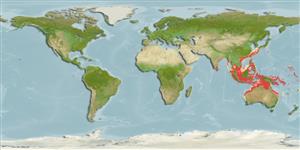Environment: milieu / climate zone / depth range / distribution range
Écologie
marin démersal. Tropical
Western Pacific: Taiwan and the South China Sea to Australia (Darwin to North West Cape).
Taille / Poids / Âge
Maturity: Lm ? range ? - ? cm
Max length : 20.0 cm SL mâle / non sexé; (Ref. 9774); common length : 12.5 cm SL mâle / non sexé; (Ref. 9774)
Épines dorsales (Total): 0; Rayons mous dorsaux (Total): 68-72; Épines anales 0; Rayons mous anaux: 52 - 55; Vertèbres: 33 - 35. Body uniformly brownish, 2 ocelli above and below lateral line and 1 ocellus on posterior third of straight section of lateral line. Many indistinct rings scattered on body and median fins. Teeth in upper jaw small and close-set with3 or 4 pairs of canines anteriorly, teeth in lower jaw stronger and more widely spaced than those in upper jaw. Gill rakers pointed and rather short. Pectoral fin on ocular side with 12-13 rays (Ref 9774).
Inhabits deep waters on mud and sand bottoms of the continental shelf (Ref. 9774). Feeds on benthic animals (Ref. 4896). Marketed fresh and salt-dried (Ref. 9774).
Life cycle and mating behavior
Maturité | Reproduction | Frai | Œufs | Fécondité | Larves
Distinct pairing (Ref. 205).
Sainsbury, K.J., P.J. Kailola and G.G. Leyland, 1985. Continental shelf fishes of the northern and north-western Australia. An illustrated guide. CSIRO Division of Fisheries Research; Clouston & Hall and Peter Pownall Fisheries Information Service, Canberra, Australia. 375 p. (Ref. 3131)
Statut dans la liste rouge de l'IUCN (Ref. 130435)
Menace pour l'homme
Harmless
Utilisations par l'homme
Pêcheries: commercial
Plus d'informations
RéférencesAquacultureProfil d'aquacultureSouchesGénétiqueElectrophoresesHéritabilitéPathologiesTraitementNutrientsMass conversion
Outils
Articles particuliers
Télécharger en XML
Sources Internet
Estimates based on models
Preferred temperature (Ref.
123201): 24.3 - 29, mean 28 °C (based on 1590 cells).
Phylogenetic diversity index (Ref.
82804): PD
50 = 0.5000 [Uniqueness, from 0.5 = low to 2.0 = high].
Bayesian length-weight: a=0.00631 (0.00374 - 0.01065), b=3.12 (2.97 - 3.27), in cm total length, based on LWR estimates for this species & Genus-body shape (Ref.
93245).
Niveau trophique (Ref.
69278): 3.5 ±0.37 se; based on food items.
Résilience (Ref.
120179): Haut, temps minimum de doublement de population inférieur à 15 mois (Preliminary K or Fecundity.).
Fishing Vulnerability (Ref.
59153): Low vulnerability (14 of 100).
